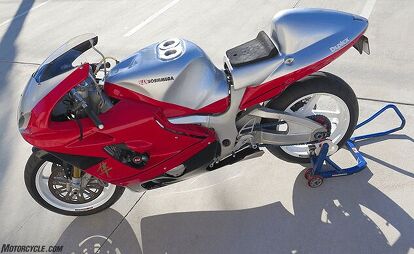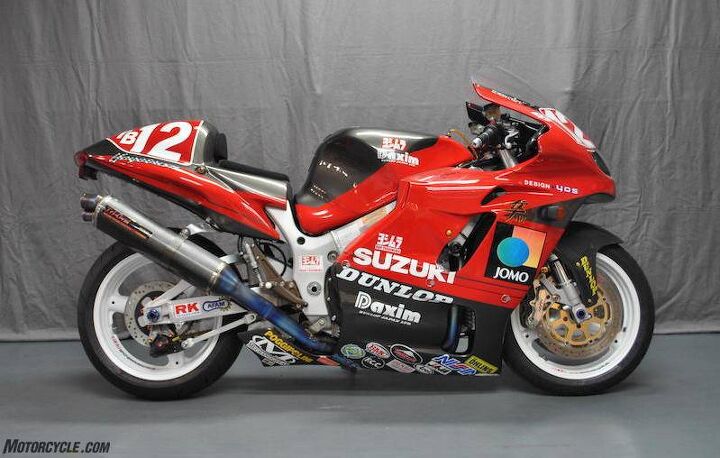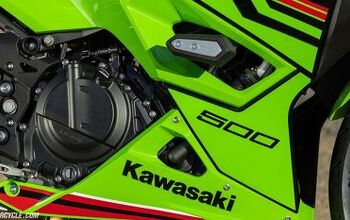Archive: Yoshimura Hayabusa X1R
Millennium Falcon
For a couple of years there’ve been rumors suggesting there’s a new Hayabusa on the way, and with that old warhorse currently MIA from Suzuki’s list of returning 2021 models, the buzz has grown a bit louder that Suzuki’s fixing to spring a new World’s Fastest Production Motorcycle on the world. This time we’ll be a bit less unsuspecting than we were in 1999, and this time, it won’t be so easy a feat for Suzuki to pull off, given the existence of the Kawasaki H2 Carbon, which made an honest 206-rear-wheel horsepower on our dyno last November.
Whether the new ’Busa is fact or fiction, it probably won’t be the earth-shattering experience the original 1999 GSX-R1300 was, a motorcycle that had no peer or precedent when it came to bouncing off its 186-mph speed governor. (Actually, as Mr. Siahaan points out, the governor didn’t appear until year two for the Hayabusa.) I still remember the day outside Barcelona when Mr. Watshisname, the Hayabusa project leader, asked us lucky “journalists,” with a sincere smile, to please respect all Spanish traffic laws. That was just before our German ride leader snapped his visor closed and twisted his Hayabusa’s throttle to the stop as we set off down the motorway. Soon, gentle freeway bends became corners where you could almost get a knee down.
The Hayabusa’s been a big hit ever since, but that of course wasn’t enough for everybody. What else are you gonna do, if your name’s Yoshimura, but build a Hayabusa to race in the Suzuka 8-Hour? Fujio Yoshimura built the X1R ’Busa to run in the X-Formula class of the famous endurance race in 1999, which his bike promptly won against a field of other heavily modified open-class production bikes. The X1R was stuffed with 12:1 forged pistons, Yosh cams and exhaust, etc., to the point where it was said to produce 193 horsepower and 105 lb-ft of torque at just 8000 rpm. All that propelling a bike Yoshimura claimed it had lightened by 37 pounds, down to 436 lbs, dry.
The next year, not at all unexpectedly, Yoshimura built 100 street-going replicas of the racer for sale to the public, the X1. Most of those 100 stayed in Japan. An X1 sold at a Bonham’s auction in England, in 2012, for £19,470 – a bit over $26k in today’s US dollars. That bike was believed to be the only one in the western world.
Wrong! There is one more X1 rattling around in the world, really more of an X1R, and it lives at our pal Chris Redpath’s MotoGP Werks in Anaheim, California. Okay, it may not be one of the original 100 built by Fujio Yoshimura. But it was totally built using official Yoshimura X1 parts, by Yoshimura R&D of America, by the same group of people led by Ammar Bazzaz who engineered Mat Mladin and Ben Spies to ten AMA Superbike championships between 1999 and 2008.
Yoshimura USA went with a slightly milder engine tune to extract a claimed 182 horses and 108 lb-ft of torque. Stage One billet cams, a little porting of the head, 12.5:1 forged pistons and Carrillo 4340 rods move the power peak up to around a nice, safe 10,500 rpm, and the torque peak to 7500 – and it’s all so nicely balanced you really don’t even miss the factory balancer shaft. (I know this because I got to lap Willow Springs on the thing 20 years ago when I worked at Motorcyclist magazine. Spotting it in Redpath’s shop gave me a bad PTSD moment.)
Yosh added a GSX-R superbike swingarm to shorten the wheelbase by 25mm and a kit Öhlins fork carried in Yosh superbike magnesium triple clamps with 30mm offset to sharpen the steering. The aluminum fuel tanks holds 6.3 gallons. Supposedly it runs fine on pump gas, or did in 2000, at least. Higher rearsets and that Yosh tailsection raise the rider a couple of inches for increased cornering clearance.
In 2000, traction control was in its infancy and I believe illegal in AMA racing; I recall Mladin was always being accused of having it. I also remember being acutely aware of all that power as I attempted to ride the X1R around the track fast enough to save face but conservatively enough to avoid catastrophe, before tire warmers were a thing. At my speed, it was stiff as a board and head-shakey over the bumps – and I’d never experienced anything with that kind of acceleration. Now, 200 horsepower is a good starting point.
Which really relegates the Heavy Bus to a back page in the history books, but a fun one to revisit – and one that reminds us what a moment the original GSX-1300R Hayabusa was. Here’s a quote from MO’s 1999 Top Speed Shootout, when we only had one other thing on our minds besides motorcycles:
“… except for the R-series Yamahas and, to a lesser degree, the Honda VFR800, no Japanese sportbike we have ever ridden has so consistently aroused the primal desires among potential mating partners as the Hayabusa.”
A fine piece of projection. Wait, what? VFR800?!
Become a Motorcycle.com insider. Get the latest motorcycle news first by subscribing to our newsletter here.
More by John Burns












































Comments
Join the conversation
Beautiful and formidable machine. It may be old, but 182 at the wheel with a broad creamy delivery never really goes out of style!
Hayabusa project leader was Mr. 'Watshisname', eh?